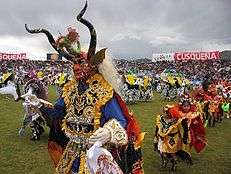Diablada puneña
Diablada puneña is a variation of the dance known as diablada performed in the region of Puno, Peru. The origin of this dance is a matter of dispute between Peru and Bolivia,[1] because both nations celebrate the Diablada with similar music, songs, and clothing.[2]

The Diablada puneña is part of an Andean theatrical repertoire that began during the Spanish colonization of South America in order to teach the local natives the precepts of Christian faith and history of the Spanish Empire. The Diablada causes a reform in the thinking of the indigenous altiplano cultures as missionaries from Spain, instilled the paradigm of good and evil, which is how the costumes of angels and demons became associated with the dance.
According to Diego Gonzáles Holguín, the missionaries taught the natives a representation of the seven deadly sins and the triumph of the angels over the demons. In Puno, this is a special dance which was recovered from the past along with the Diablada in Oruro.
History
In 1577, the Jesuits settled in Juli, Puno. During festivities, they performed theatre plays, comedies and actos sacramentales.
The Juli Jesuits taught the natives a song-dance about the seven capital sins and how the angels beat the demons, in order to indoctrinate the locals.
References
- This article was initially translated from the Spanish Wikipedia.
- Moffett, Matt; Kozak, Robert (21 August 2009). "In This Spat Between Bolivia and Peru, The Details Are in the Devils". The Wall Street Journal. p. A1. Retrieved 4 October 2009.
- Valencia Melgar. Roberto (20 February 1968). "Puno: Capital Folklórica del Perú?" [Puno Peru's folkloric capital?]. Los Andes. Puno, Peru. Archived from the original on 3 May 2010. Retrieved 10 June 2010.